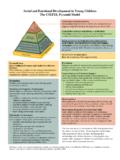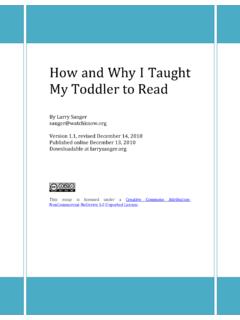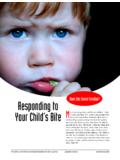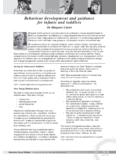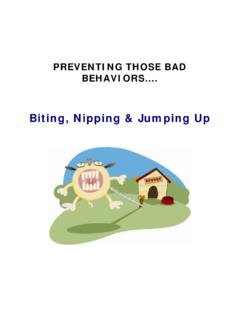Transcription of Social and Emotional Development in Young Children The ...
1 Social and Emotional Development in Young Children The CSEFEL Pyramid Model INTENSIVE INTERVENTION. Intervention: help for the few Children who need professional support to help them develop self-regulating and Social skills TARGETED Social Emotional SUPPORTS. Prevention: help for the Children who need detailed instruction to help them develop self-regulating and Social skills HIGH QUALITY SUPPORTIVE ENVIRONMENTS. NURTURING AND RESPONSIVE RELATIONSHIPS. Promotion: address the needs for most Children as they develop Social and Emotional skills. Therefore it is just above the base of the pyramid EFFECTIVE WORKFORCE. Base: the Foundation of the Support System Pyramid base Prevention Early Childhood Personnel and Families Use Effective Strategies and activities can be used to teach Children how to self- Practices regulate and learn Social skills. This helps prevent Children from When child care providers use the strategies and techniques turning to challenging behaviors.
2 Learned in the CSEFEL training, they build a solid Targeted Social and Emotional Supports foundation for Children 's Social and Emotional Development . All Young Children depend on adults to teach them how to express their feelings and regulate their emotions. Some Children Promotion may need added support in these common problem areas: Children need nurturing relationships and high quality identifying and expressing emotions environments to thrive. regulating emotions and behaviors solving Social problems Nurturing and Responsive Relationships knowing how to begin and maintain Social interactions Relationships are at the heart of healthy Development . Child developing strategies for handling disappointment and anger care providers create nurturing relationships with Children building friendship skills when they: establish a trusting relationship by actively supporting Children 's explorations Interventions Most Children do well when the promotion, the blue levels, and incorporate lessons in Children 's play activities prevention, the green level, of the pyramid are in place.
3 A small respond to Children 's words and infants' babbling number of Children continue to have behavior issues. promote all Children 's early attempts to talk encourage Children as they learn new skills Interventions Designed For an Individual Child build trusting relationships with families Some Children 's behavior will continue to be challenging. Assessment will identify what kinds of support each individual High Quality Environments child needs. A family member, the child's teacher, and other Environments that are supportive and nurturing are the next providers will work as a team to develop an intervention, or level of support. High quality environments include: behavior support plan. The plan will focus on helping the child schedules and transitions that are predictable and supportive build needed skills. positive and clear rules and expectations acceptance of all Children Children develop Social and Emotional skills with guidance from curricula that foster all areas of child Development the adults who care for them.
4 Warm responsive relationships effective teaching strategies that are developmentally with caregivers provide a safe base. Developing these appropriate and culturally sensitive relationships with Children who have challenging behaviors promotion of active learning and appropriate behavior requires skill and patience. Children are more likely to listen and supportive guiding and teaching of Social skills engaging activities that help Children learn learn needed skills from adults they trust. Reference: Center on the Social and Emo1onal Founda1ons of Early Learning. Retrieved on March 2, 2009 from Source: North Carolina Child Care Health and Safety Bulletin, April/May 2009. Promoting Social and Emotional Health: 5 Part Series PART 1. A Trained Child Care Work Force Will's Story Tucker Turtle Takes Time to Tuck and Think. The CSEFEL pyramid model rests on the solid foundation of a trained workforce. CSEFEL Tucker used to get mad and hit and yell at his trained early childhood educators are the key friends, but then he learned to think like a turtle.
5 Ingredient for success. With understanding, early When he was upset, he would STOP himself from childhood educators see why and how to create using his hands and voice. He would tuck into his supportive environments. They learn ways to shell, take three deep breathes to calm down, and strengthen their relationships with Young Children then think of a better way to solve the problem. as well as strategies for helping Children build Social and Emotional skills. They become ready and able to help Children build the confidence they need to explore and learn about themselves and others. Will attends childcare in NC. Until recently, he had been having a hard time getting along with his classmates and teachers. Many things upset him. He did not like it when a teacher tried to redirect him in his activities. It made him mad to find a child using the computer - his favorite activity! Will would kick, and push the child away. When Children joined him in play, they had to do it his way or he would yell, hit, throw toys and knock over chairs.
6 After the Children learned the turtle technique, they would say, Think like a turtle! to the child who was Will also had a hard time focusing his attention. He was upset. The Children kept a record of who used the disruptive during group activities. When teachers tried technique, how often, and why. Will was often the to engage him, Will would hit and spit at them. record keeper. Soon the board was full of the names of Afterwards, he had a hard time settling down. Children who had needed to tuck in . Each day at circle time, they talked about what caused the problem Will's teachers called in their regional behavior and what they did to make it better. It was a success specialist. The behavior specialist's first and Will became a star! Everyone's attitude about recommendation was that Will be evaluated by his Will changed. Will and his classmates were pediatrician. The evaluation resulted in a diagnosis of developing Social and Emotional competence, skills attention deficit hyperactivity disorder (ADHD).
7 This they will use for the rest of their lives. The teachers explained at least some of the issues underlying his were learning effective techniques for addressing challenging behaviors. Children with ADHD often need challenging behaviors and supporting Social and extra support in learning to focus their attention, to Emotional health, which they can use throughout their regulate their emotions and to manage their behaviors. careers. To keep him from being singled out, a plan was developed that would help Will and support all the Looking for Training? Children . Brenda Dennis: Margaret Mobley: (Healthy Social Behavior Specialist). Lanier DeGrella: (Infant Toddler Specialist). The behavior specialist taught the child care providers how to recognize early signs that a child is becoming Online Resources upset. She taught them to use soothing sensory activities CSEFEL's teacher resources: to help the child settle down. Then the behavior TACSEI (Technical Assistance Center on Social Emotional Intervention for Young Children ): specialist introduced the turtle technique.
8 Promoting Social and Emotional Health: 5 Part Series PART 2. Building Nurturing and Responsive Relationships Positive, supportive relationships between The next step was caregivers, the Children and their families, and to identify the the staff, are essential for healthy Social and Children with the Emotional Development . Within them, Children most difficult feel secure. They feel valued. Adults who take behaviors. The time to get to know the Children have more behavior specialist influence on their behavior. Children want to get advised the positive attention from these trusted adults. They caregiver to keep a pay attention to them and want to please them. In journal, with each addition, with the support of secure relationships, page divided into Children develop confidence and a positive self- two columns. In the concept. When Children feel good about first column, the themselves, they are less likely to engage in provider wrote challenging behaviors.
9 Providers can take time to down all the build healthy relationships with the Children . This negative thoughts prevents many common behavior problems. It she had about also promotes healthy Social and Emotional individual Children . Next, she reframed the negative Development . statements into positive ones. Instead of saying, He never does what I ask him to do , she said, He does A behavior specialist in North Carolina recently not understand my expectations. Then, the provider received a desperate call from a child care provider wrote down ten positive statements about each child. who was at her wits ends. She loved Children ; being As she worked through this process, she started to a teacher was all she had ever wanted to do, but she change the way she thought about the Children . This did not know what to do about the Children with allowed her to change the way she taught them. challenging behaviors. Her classroom had spun out Instead of telling them what they could not do, she of control.
10 A job she once longed for was now a job let the Children know what she expected to see in the she was ready to quit! classroom. Fortunately she did not quit. Instead, she called the Some of the Children had more serious behavior local behavior specialist. The specialist knew that problems. They needed more attention. The provider the provider's first step was to build relationships scheduled five minutes of individual time for each of with the Children and their families. This would help these Children . During this time, each child received to resolve some of the behavior issues. It might also her full attention. She followed their lead in play and renew the provider's love of teaching. She and the in discussions. As she re-established positive provider looked at the materials on building relationships with them, the Children 's challenging relationships from the Center for Social and behaviors decreased. Now she understood that her Emotional Foundations for Early Learning.
